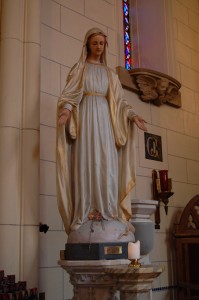 Visitation of Mary to Elizabeth
Visitation of Mary to Elizabeth
I did not grow up in a household that observed saint’s days or many holy days at all, other than Easter and Christmas. I knew about Lottie Moon, who was venerated in the weeks leading up to Christmas and Annie Armstrong who was regaled around Easter. They were the closest we had to patron saints among Southern Baptists, long on sacrifice and prayers for salvation, and short on humor or leaps of joy. Each woman was associated with a mission offering, which added to her powers of persuasion. And guilt. But I liked them both and projected onto them strength and determination, things I thought I should have when I grew up.
Today is a day in the church calendar for remembering the visit of Mary to Elizabeth, a story told in Luke’s gospel. I like this story with it’s joy and leaping, surprise and blessing. I’ve played Elizabeth in several church dramas and had my own late-in-life child. I feel less identification with Mary, although in truth, when I was quite young I imagined being “the next Mary.” Sounds embarrassing to admit now. But I heard in my church regularly that Jesus was coming back. Coming again. As far as I could tell he’d have to be born again (lot of talk of that floating around my church as well). So if he had to be born again why not to me? I think this also fed my fantasies of perfection. Oh well. Glad I outgrew that one.
Still I like the story of Luke’s text and in particular I like this blessing from Elizabeth to Mary: And blessed is she who believed that there would be a fulfillment of what was spoken to her by the Lord (Luke 1:39). In fact I blogged about this very blessing a few months ago. Many things have been attributed to the Lord. God has spoken often and at length through history according to various accounts, and yet finding fulfillment remains elusive for many, a blessing longed for rather than a promise made good.
I’ve been reading Fear and Trembling: A Dialectical Lyric by Søren Kierkegaard, written in the name and persona of Johanness de silentio. I’m barely dipping my toes in so far, but I’m seeing how Kierkegaard is trying to say that faith, and any possibility of believing in healing requires entry into paradox, risk and the accompanying distress (48-57). He was challenging the thinking in his day that invited belief in universal truths and commitment to ethical positions. The universal and the ethical were more palatable ways of making meaning than seeing particular human experience as a higher or more profound reality.
Philosophically this debate and struggle continues. For centuries western society has wrestled back and forth between universal, rational, deliberative thinking and belief systems on one hand and particular, emotional and intuitive knowing and acting on the other. It is a tangled mess we live in and from which we try to make sense. No clear winner can be declared. However, when we look to the Hebrew and Christian scriptures we find instance upon instance of the most particular, emotional, grounded, even awkward and novel stories of human beings encountering each other and the holy. The holy is not some otherworldly idea, but a stunning moment, an experience, unique and defining.
Neither Mary nor Elizabeth were acting in ways considered universally in the right or even ethically acceptable for their time. They were each living instead in a profound moment of grace. For each woman the events of those days of pregnancy and wonder changed the shape and direction of their lives forever. The same could be said of Lottie Moon and Annie Armstrong.
Something called to each woman and drew her into a particular kind of life and purpose. Many risks followed. Mary risked shame and even death for pregnancy outside of marriage. Elizabeth nearly lost her husband, and certainly risked her dignity in coming up pregnant so late in life. Lottie risked the comforts of home and the disdain of her employers as she worked tirelessly to make room for churches to take root in China. She also risked harming the reputations and lives of the people she served. Annie risked her own health for the sake of following the call she felt. She was driven by her commitment to missions and to change the world as she saw it.
But these stories bring up questions. Where is the line between vocation and blind sacrifice? What is the difference between living in faith and giving in to temptation? Kierkegaard pushes these questions in his recounting of the Abraham and Isaac story in Fear and Trembling. We each face these questions at some level every day. And beliefs deeply entangled in our hearts further complicate the responses we can make to these questions.
So Elizabeth’s blessing to Mary takes on a deeper shade of meaning when seen in the light of such difficult questions: And blessed is she who believed that there would be a fulfillment of what was spoken to her by the Lord. To really believe in the face of so much complication, in the light of novelty and risk, uncertainty and challenge? That comes closer to something we might actually call faith. To live with courage and risk into the novel and pregnant moments of life?
God, give us the courage to speak and hear that blessing by heart.



